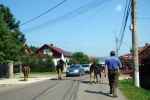
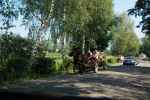
Bukovina is a land divided between Ukraine and Romania since the Second World War. We will find here gentle hills and valleys, wildlife, diversified folklore and certainly beech forests. Bukovina is inhabited by people of different ethnicity. Apart from Romanians and Ukrainians who make the vast majority, there are furthermore: Armenians, Romani people, Germans, Jews, Hungarians and numerous Poles who started to settle down here as early as in the 14th century when Bukovina, as a part of Moldavia was a Polish fief. Till the present day many Polish villages whose inhabitants speak Polish have survived in Bukovina. The southern, this is, the Romanian part of Bukovina is also famous for beautiful ‘Churches of Moldavia’ inscribed on the UNESCO World Heritage List. These ones I have already mentioned in the previous articles.
ATTENTION! Everyone who visited Romania or is planning to go there soon is kindly invited to contribute to this guide. Any inquires regarding this matter should be referred to the editor's address redakcja@libertas.pl.
Cacica (Romanian - Cacica) is the oldest Polish village (and at the same time a commune composed of five villages) in Bukovina. In 1783 the Austrian Emperor (Holy Roman Emperor) – Josef the Second who ruled in this land, ordered to search for salt deposits in Bukovina in places, where there were brine springs. The Emperor did not want to import salt from Moldavia. In result, salt was found also here and that was one of the reasons why Cacica was founded. The village took its name from numerous flocks of ducks which used to have their nests in swamps lying in this region.
In 1788 twenty Polish families from Bochnia and Wieliczka as well as four Ukrainian families from Kolomyia were arranged to move here. The settlers worked at the construction site of the salt mine which was activated in 1791. Due to its dynamical development other groups of engineers and miners from Wieliczka and the neighbourhood were soon invited to the village. First the miners had to climb down a ladder or were lowered on a rope in woven baskets in order to reach the lower parts of the salt mine. However, not until much later, in 1803 it became possible to get into all three levels by using the stairs. At present, two of three levels are available to the public and the underground route is 800 meters long.
In 1810 a small church of the Assumption of the Blessed Virgin Mary, in which both Catholics (Poles and Germans) and Greek Catholics could celebrate their worships, was built. In 1888 the first railroads were opened for traffic in the village. In 1904 a new, impressive church made of brick was consecrated by the Archbishop of Lvov - Józef Bilczewski.
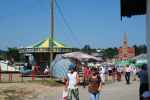


In 1944 the front line ran through the village and the inhabitants were evacuated. These ones who returned later found nothing else except for destroyed houses. In such situation many of them decided to return to Poland in 1947.
After the collapse of the communism salt mining was stopped due to economical reasons. Useless and uninteresting buildings and other premises were demolished. What survived was the administration building and the oldest mineshaft Ferdinand. In the lower, underground parts of the salt mine a tourist route was created.
In Cacica there has been a Polish Association which has been very active as well as the Polish National Home (Polish House Organization, situated near the post office) with 16 places of accommodation available to tourists and guests.
It so happened that we were visiting Cacica exactly at a time when there was a kermes in the village which regularly takes place every year in the middle of August. On this occasion the village is visited by crowds of people, not only Catholics (Poles, Romanians, Ukrainians and Hungarians), but also by clerics and followers of the Eastern Orthodox Church. Due to those ceremonies the police closed the road leading to the village; so we had to do about two kilometers on foot.


We are going down 150 stairs to get inside the lower parts of the salt mine. As the temperature here is only 10°C, we feel much more comfortable after the walk we had to take in a heat reaching almost 40 degrees because of the kermes outside. The bad thing is, however, that there is, apart from the nice temperature inside, also an unpleasant smell of oil derivatives used for wood preservation. We are going downstairs to the chapel dedicated to St. Barbara. Here we are deeply impressed by the altar and the pulpit made of salt. There are also inscriptions carved on the wall and including the names of Polish miners.
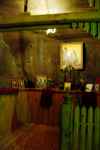
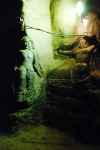
We are going further on a narrow pavement and passing by a small chapel and the relief of Adam and Eve by Bolek Majernik. 42 metres underground we are approaching a lake, or rather a brine lake with the space of 10 cubic metres. Its depth oscillates between 1.5 and 2.5 metres. Once there was a boat here, of which newly-weds and guests taking part in dances used to take their advantage.
A little bit further there is a dancing hall named after the engineer Agripa Popescu; this information can be read from an inscription carved on the wall. Agripa Popescu used to be the director of state-owned properties in 1918 when Bukovina was annexed to Romania.
We are going to the surface. It is a nice feeling to breathe in the clean air again...Unfortunately, at the same time we are being hit by a heat wave. We can see a marry-go-round spinning not far away; music is flowing from the loudspeakers; we are surrounded by a noisy crowd and an aroma of sausages. There is a short snapshot for these ones who like ‘moving pictures’.
Rumunia - przewodnik:
Satu Mare / Satmar (Romania) – guidebook (52 zdjęcia)Săpânţa - The Merry Cemetery (Romania) – guidebook (35 zdjęć)Bârsana Maramureş (Romania)– guidebook (48 zdjęć)Humor / Mănăstirea Humorului and Voronet / Voroneţ (Romania) – guidebook (32 zdjęcia)Arbore and Sucevita Monastery / Mănăstirea Suceviţa (Romania) – guidebook (43 zdjęcia)Cacica (Romania) – guidebook (21 zdjęć)Vama Veche (Romania) – guidebook (94 zdjęcia)Brasov (Romania) – guidebook (68 zdjęć)Curtea de Argeş (Romania) – guidebook (31 zdjęć)The Transfagarasan Road / Transfăgărăşan – guidebook (68 zdjęć)Sibiu / Hermannstadt (Romania) – guidebook (86 zdjęć)Hunedoara / Vajdahunyad (Romania) – guidebook (57 zdjęć)Bear Cave / Peştera Urşilor (Romania) – guidebook (29 zdjęć)Ştefan Hruşcă – kolędnik z SiedmiogroduSighetu Marmației (Romania) – guidebook (9 zdjęć)Kościoły Obronne Siedmiogrodu (Rumunia) – przewodnik (25 zdjęć)Rimetea / Torocko at the Rock of Szeklers (Romania) – guidebook (21 zdjęć)Konstanca / Constanța (Rumunia) – przewodnik (22 zdjęcia)Sighișoara (Romania) – guidebook (28 zdjęć)Mărginimea Sibiului (Romania) – guidebook (41 zdjęć)Wąwóz Galbeny / Cheile Galbenei (Rumunia) – przewodnik (23 zdjęcia)Twierdza Ponoru / Cetatile Ponorului (Rumunia) – przewodnik (19 zdjęć)Płaskowyż Padisz / Padiș (Rumunia) – przewodnik (52 zdjęcia)Wąwóz Râmeț / Cheile Râmețului (Rumunia) – przewodnik (29 zdjęć)Góry Fogaraskie – wokół jeziora Bâlea (Rumunia) – przewodnik (24 zdjęcia)